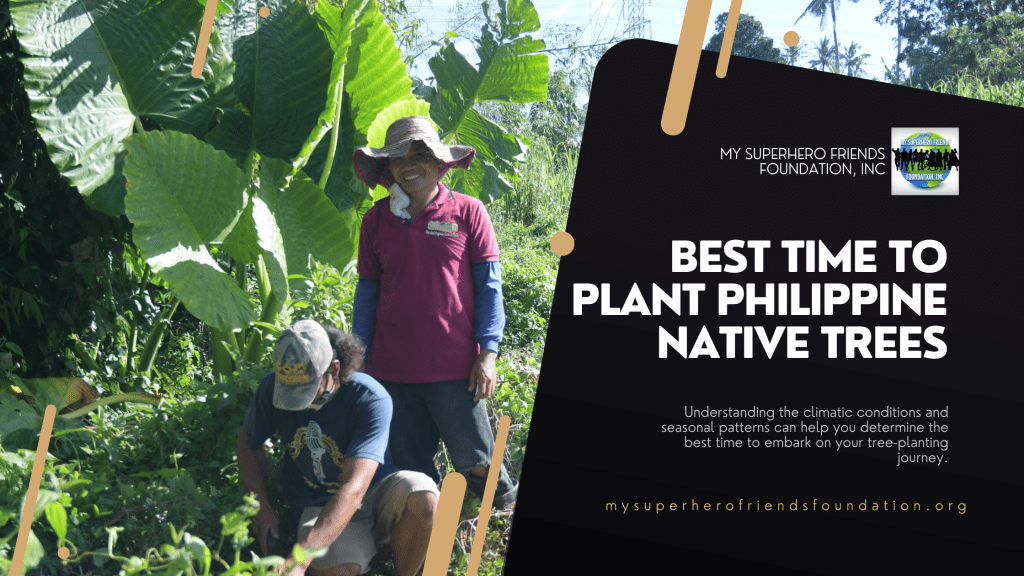Planting native trees in your garden not only enhances its aesthetic appeal but also plays a crucial role in conserving the environment and supporting local ecosystems. In the Philippines, a country known for its rich biodiversity, choosing the right time to plant native trees can significantly impact their growth and survival. Understanding the climatic conditions and seasonal patterns can help you determine the best time to embark on your tree-planting journey.

The Importance of Native Trees
Native trees are species that naturally occur in a specific region, having evolved to adapt to the local soil, climate, and ecosystem. By planting native trees in your garden, you’re fostering a connection with the local environment and contributing to the preservation of indigenous flora and fauna. These trees provide habitat and sustenance for native wildlife, help control erosion, and contribute to cleaner air and water.
Rainy Season Advantage
In the Philippines, the ideal time for planting native trees is during the rainy season, which typically runs from June to November. The arrival of the rainy season brings several benefits for newly planted trees:
- Adequate Moisture: Rainfall during this period ensures a consistent supply of water, reducing the need for frequent manual watering. Ample moisture is vital for the establishment of young trees, as it helps them develop a strong root system.
- Lower Stress: Cooler temperatures and higher humidity levels during the rainy season minimize stress on newly planted trees. This enhances their chances of survival and reduces the risk of transplant shock.
- Root Growth: The combination of warm soil and increased moisture encourages robust root growth. Healthy root systems are essential for trees to anchor themselves securely and access nutrients from the soil.
- Less Maintenance: With natural irrigation provided by rainfall, you’ll spend less time and effort on watering your newly planted trees, allowing you to focus on other aspects of garden care.
Preparation and Planning
Before the rainy season begins, it’s crucial to plan and prepare for your tree-planting endeavor:
- Species Selection: Research and select native tree species that are well-suited to your region’s climate and soil conditions. Different species have varying water and sunlight requirements.
- Site Preparation: Clear the planting area of weeds, debris, and invasive plants. Loosen the soil to improve aeration and drainage.
- Mulching: Apply a layer of organic mulch around the base of the newly planted trees. Mulch helps retain soil moisture, suppresses weed growth, and moderates soil temperature.
- Watering Schedule: While the rainy season provides natural watering, monitor the soil moisture levels. If there are prolonged dry spells, consider supplementary watering to prevent the soil from becoming too dry.
Beyond the Rainy Season
While the rainy season is the optimal time for planting native trees, your commitment to their care should extend beyond this period:
- Regular Monitoring: Keep an eye on the growth and health of your trees. Prune any dead or diseased branches to promote healthy development.
- Weeding: As your trees grow, continue to manage weeds that can compete for nutrients and water.
- Fertilization: Depending on the tree species and soil conditions, consider providing appropriate fertilization to support growth. Consult local experts for guidance.
- Pest and Disease Control: Be vigilant against pests and diseases that can affect tree health. Early detection and intervention are essential.
In conclusion, the rainy season in the Philippines, from June to November, offers the best conditions for planting native trees in your garden. This period ensures sufficient moisture, reduced stress on young trees, and optimal root growth. Proper planning, species selection, and ongoing care are essential for the success of your tree-planting initiative. By contributing to the conservation of Philippine native trees, you’re making a positive impact on the environment and the beauty of your surroundings that will endure for generations to come.
